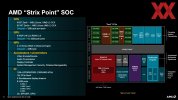Install the app
How to install the app on iOS
Follow along with the video below to see how to install our site as a web app on your home screen.
Note: This feature may not be available in some browsers.
You are using an out of date browser. It may not display this or other websites correctly.
You should upgrade or use an alternative browser.
You should upgrade or use an alternative browser.
Most likely from faster memories used in the laptop, 880M has under 4 % higher clocks than 780M and both have 12 CUs. The other changes in RDNA3.5 shouldn't make that drastic difference.
Also from the improved perf/W naturally but while AMD claimed up to 32%, this is a bit underwhelming. Perhaps the 16CU part could come closer as it could be clocked lower and take advantage of being lower on the V/F curve.Most likely from faster memories used in the laptop, 880M has under 4 % higher clocks than 780M and both have 12 CUs. The other changes in RDNA3.5 shouldn't make that drastic difference.

Valve employee taking a guess from the above slide that there are potentially VOPD encoded formats of V_INTERP and V_CMP instructions. Wave64 mode is clearly starting to be the preferred SIMD width in terms of performance/area design ...
Supposedly it was planned with 16MB Infinity cache at one point in its design phase but it was dropped later due to cost reasons. Would certainly have helped both power/performance and been more useful than the NPU for most consumers. Phoenix had just 2 MB L2, Strix Point should have at least 4 MB I would think (Intel has gone to 8 MB with Lunar Lake).
And Strix Halo has 32 MB Infinity cache as per rumoured specs.
So Strix Point has the same L2 as Phoenix, 2 MB, and only LPDDR5-7500 support. Surprised they didn't go with 8533. From the leaks so far, the GPU performance has seemed quite underwhelming so far and these appear to be why.
Intel looks to be making significant jumps with Lunar Lake and again with Panther Lake next year. AMD will need to make a large jump with Zen 6 APUs to stay ahead.

Frenetic Pony
Veteran
These 2 reviews are all that matter, 14w average SOC pull: https://www.phoronix.com/review/amd-radeon-890m-rdna35/2
Solidly faster than a Series S: https://www.anandtech.com/show/21485/the-amd-ryzen-ai-hx-370-review/9
Absolutely amazing job, AMD finally nails it architecture wise, just to have the first product they put it in gimped by MS pushing everyone to cash in on "AI hype" rather than letting the 16mb of infinity cache that would allow actual scaling to the products TDP range. Still, it's great news for the future. Suddenly I believe that "3.4ghz max boost clock" RDNA4 leak.
Solidly faster than a Series S: https://www.anandtech.com/show/21485/the-amd-ryzen-ai-hx-370-review/9
Absolutely amazing job, AMD finally nails it architecture wise, just to have the first product they put it in gimped by MS pushing everyone to cash in on "AI hype" rather than letting the 16mb of infinity cache that would allow actual scaling to the products TDP range. Still, it's great news for the future. Suddenly I believe that "3.4ghz max boost clock" RDNA4 leak.
Subtlesnake
Regular
Are you sure it's solidly better than a Series S? There Cyberpunk is running with 34 FPS as the floor at 1080p medium, while on the S they target 1440p/30 with I believe a mix of medium and high settings.These 2 reviews are all that matter, 14w average SOC pull: https://www.phoronix.com/review/amd-radeon-890m-rdna35/2
Solidly faster than a Series S: https://www.anandtech.com/show/21485/the-amd-ryzen-ai-hx-370-review/9
Absolutely amazing job, AMD finally nails it architecture wise, just to have the first product they put it in gimped by MS pushing everyone to cash in on "AI hype" rather than letting the 16mb of infinity cache that would allow actual scaling to the products TDP range. Still, it's great news for the future. Suddenly I believe that "3.4ghz max boost clock" RDNA4 leak.
It’s 1440p output upscaled via FSR 2 from 720p if memory serves. I also don’t recall it being a mix of high and medium.Are you sure it's solidly better than a Series S? There Cyberpunk is running with 34 FPS as the floor at 1080p medium, while on the S they target 1440p/30 with I believe a mix of medium and high settings.
Subtlesnake
Regular
Before FSR was patched in 1.61, DF tested 1.5 and found that the lowest resolution on the S was 2304x1296.It’s 1440p output upscaled via FSR 2 from 720p if memory serves. I also don’t recall it being a mix of high and medium.

Cyberpunk 2077's next-gen patch tested on PS5 and Xbox Series consoles
Welcome back to Cyberpunk 2077, a game transformed for PlayStation 5 and Xbox Series consoles. The prior 'back-compat p…
In the video, Thomas indicates that the settings on the S are a match for the XSX and PS5 versions in their respective fidelity modes, apart from the addition of RT shadows and better SSR reflections in the "RT mode".
Frenetic Pony
Veteran
It'd be interesting to see a direct settings comparison on one of these things, it's hard to know right now what settings people are testing these on, or whether they updated the bios or not, or what the power draw actually is, etc.
Solid results at lower TDPs where the increased power efficiency has the biggest effect but the lack of improvement in memory bandwidth or additional infinity cache does show at higher power settings and I doubt 890M will be significantly faster than 880M at higher power levels.These 2 reviews are all that matter, 14w average SOC pull: https://www.phoronix.com/review/amd-radeon-890m-rdna35/2
Solidly faster than a Series S: https://www.anandtech.com/show/21485/the-amd-ryzen-ai-hx-370-review/9
Absolutely amazing job, AMD finally nails it architecture wise, just to have the first product they put it in gimped by MS pushing everyone to cash in on "AI hype" rather than letting the 16mb of infinity cache that would allow actual scaling to the products TDP range. Still, it's great news for the future. Suddenly I believe that "3.4ghz max boost clock" RDNA4 leak.
Apparently the size of the NPU is as much as 8 CUs or 4 Zen5c cores which is significant. No wonder they didn't want to invest additional die area on infinity cache. I really hope they fix this with Zen 6 APUs, otherwise performance will just not scale.
Also keep in mind that Series has significantly more memory bandwidth (~2.5X?) and obviously power limits so I highly doubt Strix Point even at 50W would come close.Are you sure it's solidly better than a Series S? There Cyberpunk is running with 34 FPS as the floor at 1080p medium, while on the S they target 1440p/30 with I believe a mix of medium and high settings.
Frenetic Pony
Veteran
AI 370 limited to 18w runs Hellblade 2 not that differently than Series S.
Looking forward to something like a Z2 SOC w/Zen5+ next year, 16mb cache and cutting CPU core count in half (what game uses 12 cores anyway) should yield similar performance on a 15w handheld.
Looking forward to something like a Z2 SOC w/Zen5+ next year, 16mb cache and cutting CPU core count in half (what game uses 12 cores anyway) should yield similar performance on a 15w handheld.
we need rdna 4 to be good and enter mobile apu's for us to get series s performance on the go. But not much longerAI 370 limited to 18w runs Hellblade 2 not that differently than Series S.
Looking forward to something like a Z2 SOC w/Zen5+ next year, 16mb cache and cutting CPU core count in half (what game uses 12 cores anyway) should yield similar performance on a 15w handheld.
AI 370 limited to 18w runs Hellblade 2 not that differently than Series S.
Looking forward to something like a Z2 SOC w/Zen5+ next year, 16mb cache and cutting CPU core count in half (what game uses 12 cores anyway) should yield similar performance on a 15w handheld
Unlikely they'll make a new SoC but there's Kraken coming which is 4 x Zen 5 + 4x Zen 5c cores and 8 CUs I believe, which should be great for a handheld. No infinity cache but 128 bit LPDDR5X should be enough for 8 CUs.
The rumors are that the apus will skip rdna4 and go straight to 5 in two years
Yep rumored to go straight to RDNA5 with Zen 6 and the desktop and mobile APUs will effectively converge it seems.
Huh? There's no such thing as 'destkop APUs'Yep rumored to go straight to RDNA5 with Zen 6 and the desktop and mobile APUs will effectively converge it seems.
So far we have the mobile APUs, will have soon stronger but still mobile halo APU and then there's Mi300A.
G series are desktop APU's.Huh? There's no such thing as 'destkop APUs'
So far we have the mobile APUs, will have soon stronger but still mobile halo APU and then there's Mi300A.
Or are you talking about Zen 5 specifically?
But they're literally the same mobile APUs in desktop packageG series are desktop APU's.
Or are you talking about Zen 5 specifically?
Basically mainstream desktop and laptop will be the same APU, there wont be a different part for desktop. For high end I think they will have separate chips.Huh? There's no such thing as 'destkop APUs'
So far we have the mobile APUs, will have soon stronger but still mobile halo APU and then there's Mi300A.
But that's what we already have? The desktop APUs are literally the same chips as mobile APUs, only difference is packaging.Basically mainstream desktop and laptop will be the same APU, there wont be a different part for desktop. For high end I think they will have separate chips.
Similar threads
- Replies
- 85
- Views
- 11K
- Replies
- 183
- Views
- 19K
- Replies
- 85
- Views
- 17K
- Replies
- 57
- Views
- 8K
- Replies
- 15
- Views
- 2K
